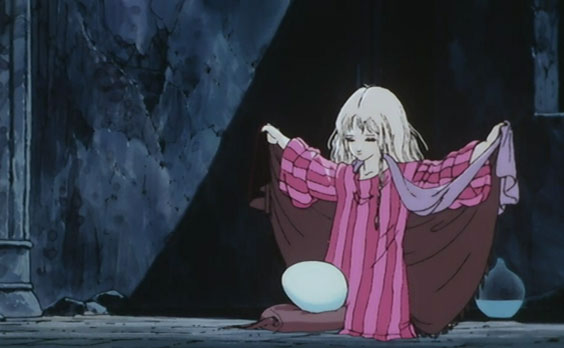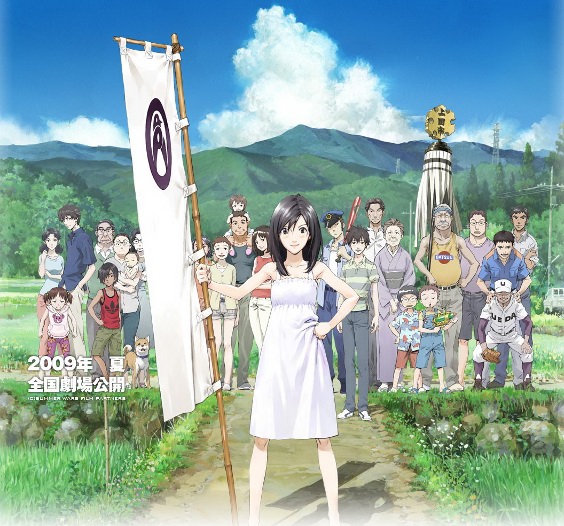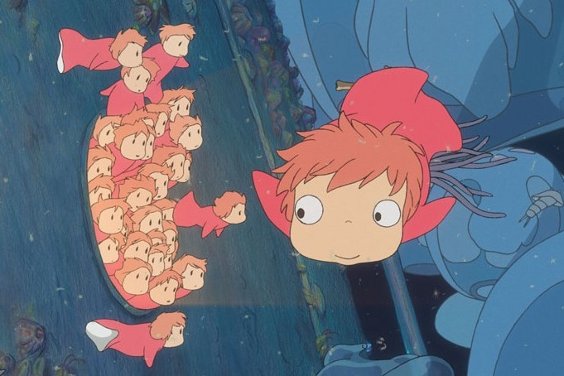This past weekend I went up to Leeds for the Leeds International Film Festival’s anime programming (which is also part of the Thought Bubble comic con). A bit of hike, but they had Summer Wars and Angel’s Egg on. Having waited until The Girl Who Leapt Through Time arrived in London last time, I ended up seeing a very dirty print, so I wanted to see Summer Wars before the festival print ended up looking like it had been dragged through a hedge backwards. Plus, to see Angel’s Egg in a cinema was probably going to be a once a lifetime thing, so I didn’t want to miss that either.
It was well worth the trip. If you are in the UK and interested in anime itself rather than fancy dress or going a disco that plays Japanese pop music, then going to Leeds International Film Festival should be on the top of your list of things to do next year over the traditional UK anime conventions or the MCM Expo events. While I missed Thought Bubble, itself as I was in York on the Saturday, I heard good things about it from the guys in the Leeds Travelling Man on the Sunday, so I’ll definitely think about going along to that too next year.
Angel’s Egg

While I was a little disappointed that it was a digital presentation (with a little distortion in projection that came with it), once you heard the paper trail that the organisers had to go through to find a copy in Japan in the first place (meaning they only had a month to subtitle it), you could forgive the little problems with the presentation.
I’d seen the final 10 minutes of it over a decade ago, when it had overrun during a convention video program. Adding to that the fact it’s probably been talked about in English more than it’s been seen in English, I’ve been wondering if the film feels any different to people who don’t know how it ends? There’s a dread inevitability to it when you do know, similar to how I felt the first time I saw Mad Max (another film whose key event isn’t the finale, but is much talked about, and happens near the end of the film).
That undercuts the surreal nature of the world in the film, and without that knowledge, I wonder if the film does come off as too strange. Nevertheless, it sure looks great. Oshii was bringing with him a lot of the shots (particularly movement across shadows) that he developed in Urusei Yatsura. Episode 53 of that series and the film Beautiful Dreamer are obvious reference points with their deserted towns inhabited by residents who only seem to exist in the corner of your eye.
The imagery is all very solid, with clearly a lot of thought put into the design elements. Both in Yoshitaka Amano’s design work and the layouts. You can easily take pieces of the film and find meaning in them. Most obviously there is Christian imagery, but there’s parts that reminded me of OCD behaviour (the fishermen, the girl’s collecting of water, the soldier’s obsession with the egg), parts that seemed straight up 1970’s prog rock album cover art (the opening scene with the arrival of the sphere of angels especially) and simpler imagery like how the soldier’s weapon is seeming made of motorcycle parts.
However, if you try and find sense in the film as a whole, then you may be on a hiding to nothing. And that’s entirely deliberate on Oshii’s part. Ambiguity is the name of the game here, a collection of visual and philosophical ideas rather than a single comprehensive narrative.
Probably my third favourite Oshii work behind Patlabor and UY, though I do think a great deal of that though is down to Amano’s designs and Yoshihiro Kanno’s score. Because they are so rarely seen in animation nowadays it gives it a special quality that takes it over the edge.
Summer Wars

When the virtual world of Oz is attacked, it infringes on the real life of maths genius Kenji who has found himself at the family gathering of his crush Natsuki Shinohara. Natsuki has hired him for a “summer job”, and he and the extended Shinohara family have to fight back against the mysterious attacker of Oz.
While I didn’t enjoy it quite as much as The Girl Who Leapt Through Time, this felt more like a Mamoru Hosoda film. There’s a couple of elements to this, firstly, and most obviously, is in the virtual world of Oz itself. Oz feels like an extension of the SUPERFLAT MONOGRAM short he directed for Takashi Murakami/Louis Vuitton and the virtual worlds of the Digimon Our War Game! The virtual world is super clean, coloured in colours that feel beyond nature and full of so much detail you aren’t going to catch every little nuance straight away. Also, the nature of the shots feel different to the shots he uses in the “real world”, far more movement and less composed wide shots (Hosoda may love a wide shot as much as Wes Anderson).
Secondly, the nature of the “villain”. Love Machine was distinctly alien, akin to Our War Game‘s Diablomon or Baron Omatsuri and the Secret Island‘s Lily Carnation. These are all creatures that, for one reason or another, can’t be reasoned with. They also have alien appearances to match their alien behaviour. Here we have Love Machine’s permanent rictus grin, and a variety of forms calling to mind Raijin and Devilman.
Going back to the Our War Game! comparison, the plot of Summer Wars does have an awful lot in common with that earlier and shorter film (cut and made part of Digimon The Movie in the West). Both feature a virtual world corrupted, that then has negative effects on the real world’s infrastructure, a climax involving a countdown to annihilation and an ending that feels like a variation on the “Do You Believe In Fairies?” Tinkerbell resurrection in Peter Pan.
However that’s only half the story, the other half involving the Shinohara family gathering deals with the other element that Hosoda’s known for, human life. Despite the fact that he often frames shots spectacularly wide and straight onto the action, to the point where you might expect them to take on a staged artifice, his humans feel human and the world they live in feels real. When you see the dining table straight on from the outside of the house, it’s more like you’re standing in the garden looking in on a family, than seeing characters perform to you as an audience.
Likewise the countryside of Nagano that much of the real world action takes place in feels as real as the people. Like in The Girl Who Leapt Through Time, he frequently fills much of the screen with sky (or here, lush green countryside) leaving the action towards the lower half of the screen, which makes you feel like you’re on the ground level with the characters, in their world. Which is pretty much your world too, give or take an internet with an over the top GUI. And none of this achieved by slavish photo-referencing or rotoscoping, a lot of the movement and behaviour is still exaggerated and caricature-like. But the way he shoots it and the way the characters interact with each other, gives it a grounded feel even when they’re are performing slapstick action like dropping a fishing vessel in the family koi pond.
Best of all though is the way the two elements are drawn together both by the plot (one of the Shinohara family is a famous gamer on Oz) and by the themes of the film, namely the value of social interaction. Earlier in the film the matriach of the family, Sakae uses the social network she’s built up in her 90 years of life to fix some of the problems Love Machine is causing in the real world. We then see an extension of that in the world of Oz, when we get the aforementioned Tinkerbell moment at the climax.
A weaker film would be making a judgement that interacting the real world is better than interacting in a virtual world like Oz, instead it’s point is that the interaction in virtual world is an extension of the real world, and so you should treat it like the real world. Love Machine is the villain (and seems so alien) because he is incapable of doing that, both the virtual and real worlds are just a game to it.
Great film, can’t wait to see what Hosoda and team do next. Would love a straight up comedy as the comedy parts here are just as strong as The Girl Who Leapt Through Time and outside of Shin-Chan films there aren’t enough comedy anime films. But whatever it turns out to be I’ll be eagerly awaiting it.
Ponyo

After the mess that was Howl’s Moving Castle, this take on the Little Mermaid was a great return to form for Miyazaki. Easily the most packed house of the three films, the morning showing I was in was almost sold out, and there were a lot of families in.
It’s Miyazaki and it’s great. Not only is it beautiful to look at, Miyazaki gets what kids want in a movie better than anyone (as opposed to films that have what adults think kids want). A girl in the front row loudly proclaimed to her grandmother as the film started that “I don’t want to keep quiet!”, but as soon as Ponyo herself appeared on the screen she was quiet and rapt to the screen. In fact apart from one kid near the back who got distressed when Ponyo was taken back under the sea by her father, all the kids in the audience were obviously rapt by the film, not a bored murmur at all. And that kid was happy again once Ponyo made her triumphant return to land. This was the subtitled version too, I’ve never bought the idea that kids won’t read subtitles and no one seemed to be having problems with it. Well no kids, I heard a couple of adults complain.
Can’t quite decide where I’d place it Miyazaki’s work, but it’s definitely up there for me. Probably need to watch Totoro, Porco Rosso or Spirited Away again to judge.
And am I the only one who thinks fish Ponyo’s face looks a bit like Pob?